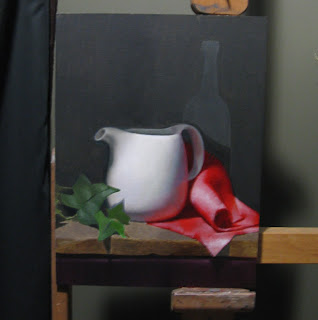Today, I moved on modelling the white pot, laid down some fresh green on the leaves, and then got a start on something new with the cloth: Indirect Painting.
Background: Some colours are so bright and intense that there's no way to mix the paint to achieve realistic highlights. If you merely mix white and red to achieve a lighter red, pink will result. The same thing will happen with some bright greens, blues, and violets. In my still life exercise here, I have a bright red cloth (almost pure cadmium red) with a large roll in it. I tried modelling the lightest part of the roll with cadmium orange and yellow mixed in with the red, but even that didn't brighten up the area in the way I wanted... So that's why indirect painting has to be done.
Here's the general idea: To achieve highlights, a coat of white is put down first over the original local colour (cadmium red). When the white dries, glazes of red are reapplied and the white shines through, not as pink but as a lighter red.
To begin, the original layer of red must be completely dry so that the fresh white doesn't combine with it to make pink. A small test confirms this. Next, pure white is added in all areas where the cloth is a lighter red than its local colour, in my case pure cadmium red, a perfect 5 on the value scale of 0 to 9. Where the red cloth is at its lightest, I applied the white paint at its full intensity. (Note: Juan recommended mixing some calcium carbonate to my flake white to ensure it would be as opaque as possible). As I move from the lightest red to the local colour red, I thin out and blend the white paint towards the pure red.
Two brushes are needed: one to lay down the pure white, and one absolutely clean brush to blend it out and lift it off as your move to the darker reds... (The mantra I think is: brush in, brush out)
In my picture below, the whitest whites are where the cloth shows off the lightest reds...
In two weeks' time, this white will be dry. Then I'll begin adding glazes of red on top. There no harm in having the white too white; I can always darken later. But the reverse is not true: If after applying the red glazes I find that the highlights are not bright enough because the white underneath was not opaque enough, then tough luck. It's too late to fix it.
Subscribe to:
Post Comments (Atom)




No comments:
Post a Comment